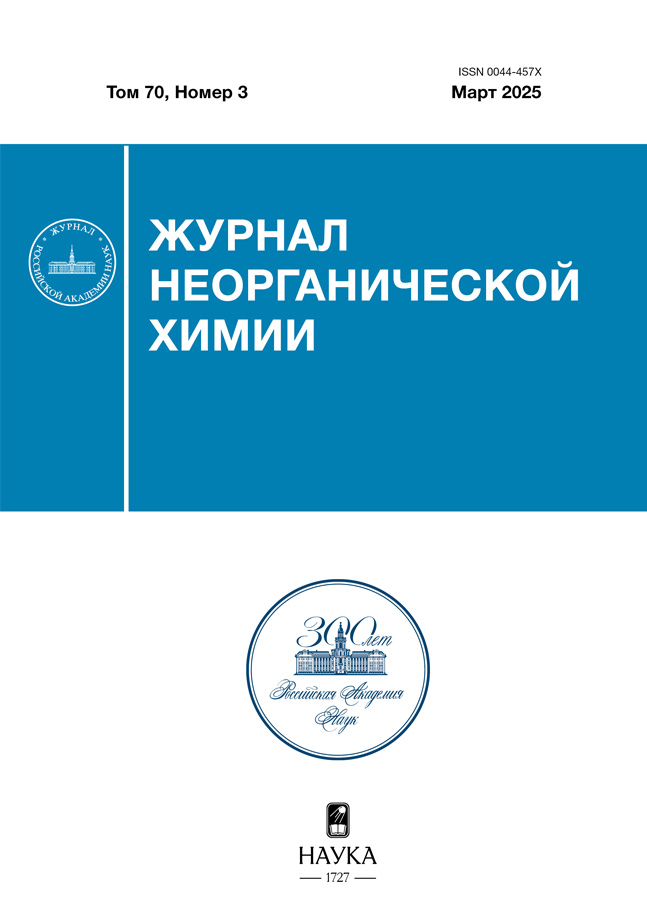Plasma electrolytic synthesis and characterization of bismuth-containing oxide films on titanium
- 作者: Popov D.P.1,2, Vasilyeva M.S.1,2, Kuryavyi V.G.2, Korochentsev V.V.2, Egorkin V.S.2
-
隶属关系:
- Far Eastern Federal University
- Institute of Chemistry, Far Eastern Branch, Russian Academy of Sciences
- 期: 卷 70, 编号 3 (2025)
- 页面: 402-410
- 栏目: НЕОРГАНИЧЕСКИЕ МАТЕРИАЛЫ И НАНОМАТЕРИАЛЫ
- URL: https://www.clinpractice.ru/0044-457X/article/view/684989
- DOI: https://doi.org/10.31857/S0044457X25030121
- EDN: https://elibrary.ru/BAVFIB
- ID: 684989
如何引用文章
详细
Bismuth-containing films on titanium were formed by single-stage plasma electrolytic oxidation (PEO) in pulsed mode in an electrolyte with dispersed particles containing metallic bismuth. The surface morphology and composition of the obtained films were studied by scanning electron microscopy, X-ray phase analysis, Energy-dispersive analysis and X-ray photoelectron spectroscopy. Modification of Ti/TiO2 films with bismuth leads to the appearance of anodic photocurrents in the visible region of the spectrum, a shift in the potentials of flat bands to the cathode region and an increase in the concentration of charge carriers. It is shown that the characteristics and properties of the obtained film composites are noticeably affected by the pulse duration t (0.02 or 0.05 s). At t = 0.02 s, films containing cubic particles with a diameter of 0.2 to 1 μm with an increased bismuth content are formed. Such films have a small band gap of 1.62 eV and exhibit the highest photoelectrochemical activity under the influence of visible light.
全文:
作者简介
D. Popov
Far Eastern Federal University; Institute of Chemistry, Far Eastern Branch, Russian Academy of Sciences
Email: vasileva.ms@dvfu.ru
俄罗斯联邦, Vladivostok; Vladivostok
M. Vasilyeva
Far Eastern Federal University; Institute of Chemistry, Far Eastern Branch, Russian Academy of Sciences
编辑信件的主要联系方式.
Email: vasileva.ms@dvfu.ru
俄罗斯联邦, Vladivostok; Vladivostok
V. Kuryavyi
Institute of Chemistry, Far Eastern Branch, Russian Academy of Sciences
Email: vasileva.ms@dvfu.ru
俄罗斯联邦, Vladivostok
V. Korochentsev
Institute of Chemistry, Far Eastern Branch, Russian Academy of Sciences
Email: vasileva.ms@dvfu.ru
俄罗斯联邦, Vladivostok
V. Egorkin
Institute of Chemistry, Far Eastern Branch, Russian Academy of Sciences
Email: vasileva.ms@dvfu.ru
俄罗斯联邦, Vladivostok
参考
- Cheng G., Liu X., Xiong J. // Chem. Eng. J. 2024. P. 157491. https://doi.org/10.1016/j.cej.2024.157491
- Bopape D.A., Ntsendwana B., Mabasa F.D. // Heliyon. 2024. V. 10. P. E39316. https://doi.org/10.1016/j.heliyon.2024.e39316
- Ali T., Ahmed A., Alam U. et al. // Mater. Chem. Phys. 2018. V. 212. P. 325. https://doi.org/10.1016/j.matchemphys.2018.03.052
- Maeda K., Domen K. // J. Phys. Chem. Lett. 2010. V. 1 P. 2655. https://doi.org/10.1021/jz1007966
- Barbosa M.O., Moreira N.F.F., Ribeiro A.R. et al. // Water Res. 2016. V. 94. P. 257. https://doi.org/10.1016/j.watres.2016.02.047
- Fujishima A., Rao T.N., Tryk D.A. // J. Photochem. Photobiol. C: Photochem. Rev. 2000. V. 1. P. 1. https://doi.org/10.1016/S1389-5567(00)00002-2
- Liu Z., Wang Q., Tan X. et al. // Alloys Compd. 2020. V. 815. P. 152478. https://doi.org/10.1016/j.jallcom.2019.152478
- Chen Y., Chen D., Chen J. et al. // Alloys Compd. 2015. V. 651. P. 114. https://doi.org/10.1016/j.jallcom.2015.08.119
- Pellegrino G., Mineo G., Strano V. et al. // Colloids Surf. A: Physicochem. Eng. Asp. 2025. V. 705. P. 135738. https://doi.org/10.1016/j.colsurfa.2024.135738
- Borilo L.P., Mal’chik A.G., Kuznetsova S.A. et al. // Russ. J. Inorg. Chem. 2014. V. 59. P. 1065. https://doi.org/10.1134/S0036023614100039
- Ilsatoham M.I., Alkian I., Azzahra G. et al. // Results Eng. 2023. V. 17. P. N100991. https://doi.org/10.1016/j.rineng.2023.100991.
- Cai N., Mai Y., Su R. et al. // Mater. Lett. 2024. V. 365. P. 136464. https://doi.org/10.1016/j.matlet.2024.136464
- Alizad S., Fattah-alhosseini A., Karbasi M. et al. // Ceram. Int. 2024. V. 50. № 22. P. 45083. https://doi.org/10.1016/j.ceramint.2024.08.347
- Vasilyeva M.S., Lukiyanchuk I.V., Budnikova Yu.B. et al. // ChemPhysMater. 2024. V. 3. № 3. P. 293. https://doi.org/10.1016/j.chphma.2024.03.003
- Vasilyeva M.S, Lukiyanchuk I.V., Sergeev A.A. et al. // Surf. Coat. Technol. 2021. V. 424. P. 127640. https://doi.org/10.1016/j.surfcoat.2021.127640
- Rogov A.B. // Mater. Chem. Phys. 2015. V. 167 P. 136. https://doi.org/10.1016/j.matchemphys.2015.10.020
- Rogov A.B., Terleeva O.P., Mironov I.V. et al. // Appl. Surf. Sci. 2012. V. 258. P. 2761. https://doi.org/10.1016/j.apsusc.2011.10.128
- Amsheeva A.A. // J. Anal. Chem. 1978. V. 33. № 6. P. 814. WOS:A1978GF08000003
- Moulder F., Stickle W.F., Sobol P.E. et al. Handbook of X-ray Photoelectron Spectroscopy, Eden Prairie: Physical Electronics, USA, 1995. 262 p.
- Salmanzadeh-Jamadi Z., Habibi-Yangjeh A., Khataee A. // J. Ind. Eng. Chem. 2024. V. 143. P. 354. https://doi.org/10.1016/j.jiec.2024.08.037
- Liang Y.-C., You S.-Y., Chen B.-Y. // Int. J. Mol. Sci. 2022. V 23. P. 12024. https://doi.org/10.3390/ijms231912024
- He Y., Cai J., Zhang L. et al. // Ind. Eng. Chem. Res. 2014. V. 53. № 14. P. 5905. https://doi.org/10.1021/ie4043856
- Muñoz A.G. // Electrochim. Acta. 2007. V. 52. № 12. P. 4167. https://doi.org/10.1016/j.electacta.2006.11.035
- Tsui L., Homma T., Zangari G. // J. Phys. Chem. C. 2013. V. 117. № 14. P. 6979. https://doi.org/10.1021/jp400318n
- Schneider M., Schroth S., Schilm J. et al. // Electrochim. Acta. 2009. V. 54. № 9. P. 2663. https://doi.org/10.1016/j.electacta.2008.11.003
补充文件















